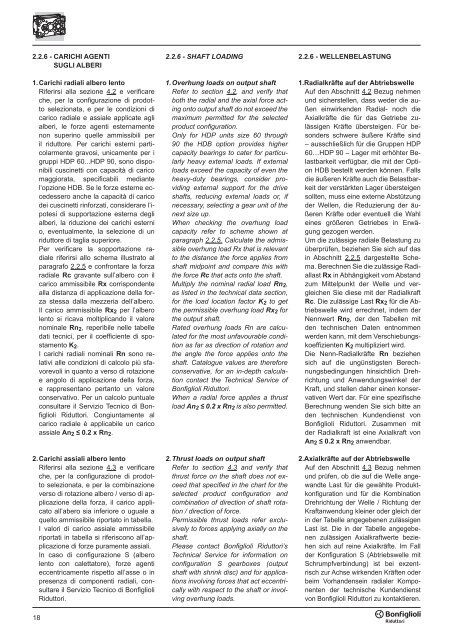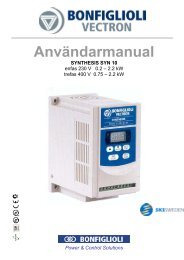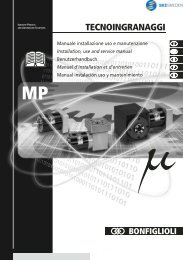Br cat HDP 60-160 p001.vp - SKS Sweden
Br cat HDP 60-160 p001.vp - SKS Sweden
Br cat HDP 60-160 p001.vp - SKS Sweden
You also want an ePaper? Increase the reach of your titles
YUMPU automatically turns print PDFs into web optimized ePapers that Google loves.
2.2.6 - CARICHI AGENTI<br />
SUGLI ALBERI<br />
1. Carichi radiali albero lento<br />
Riferirsi alla sezione 4.2 e verificare<br />
che, per la configurazione di prodotto<br />
selezionata, e per le condizioni di<br />
carico radiale e assiale appli<strong>cat</strong>e agli<br />
alberi, le forze agenti esternamente<br />
non superino quelle ammissibili per<br />
il riduttore. Per carichi esterni particolarmente<br />
gravosi, unicamente per i<br />
gruppi <strong>HDP</strong> <strong>60</strong>...<strong>HDP</strong> 90, sono disponibili<br />
cuscinetti con capacità di carico<br />
maggiorata, specificabili mediante<br />
l’opzione HDB. Se le forze esterne eccedessero<br />
anche la capacità di carico<br />
dei cuscinetti rinforzati, considerare l’ipotesi<br />
di supportazione esterna degli<br />
alberi, la riduzione dei carichi esterni<br />
o, eventualmente, la selezione di un<br />
riduttore di taglia superiore.<br />
Per verificare la sopportazione radiale<br />
riferirsi allo schema illustrato al<br />
paragrafo 2.2.5 e confrontare la forza<br />
radiale Rc gravante sull’albero con il<br />
carico ammissibile Rx corrispondente<br />
alla distanza di applicazione della forza<br />
stessa dalla mezzeria dell’albero.<br />
Il carico ammissibile Rx 2 per l’albero<br />
lento si ricava moltiplicando il valore<br />
nominale Rn 2 , reperibile nelle tabelle<br />
dati tecnici, per il coefficiente di spostamento<br />
K 2 .<br />
I carichi radiali nominali Rn sono relativi<br />
alle condizioni di calcolo più sfavorevoli<br />
in quanto a verso di rotazione<br />
e angolo di applicazione della forza,<br />
e rappresentano pertanto un valore<br />
conservativo. Per un calcolo puntuale<br />
consultare il Servizio Tecnico di Bonfiglioli<br />
Riduttori. Congiuntamente al<br />
carico radiale è applicabile un carico<br />
assiale An 2 ≤ 0.2 x Rn 2 .<br />
2. Carichi assiali albero lento<br />
Riferirsi alla sezione 4.3 e verificare<br />
che, per la configurazione di prodotto<br />
selezionata, e per la combinazione<br />
verso di rotazione albero / verso di applicazione<br />
della forza, il carico appli<strong>cat</strong>o<br />
all’abero sia inferiore o uguale a<br />
quello ammissibile riportato in tabella.<br />
I valori di carico assiale ammissibile<br />
riportati in tabella si riferiscono all’applicazione<br />
di forze puramente assiali.<br />
In caso di configurazione S (albero<br />
lento con calettatore), forze agenti<br />
eccentricamente rispetto all’asse o in<br />
presenza di componenti radiali, consultare<br />
il Servizio Tecnico di Bonfiglioli<br />
Riduttori.<br />
2.2.6 - SHAFT LOADING<br />
1. Overhung loads on output shaft<br />
Refer to section 4.2, and verify that<br />
both the radial and the axial force acting<br />
onto output shaft do not exceed the<br />
maximum permitted for the selected<br />
product configuration.<br />
Only for <strong>HDP</strong> units size <strong>60</strong> through<br />
90 the HDB option provides higher<br />
capacity bearings to <strong>cat</strong>er for particularly<br />
heavy external loads. If external<br />
loads exceed the capacity of even the<br />
heavy-duty bearings, consider providing<br />
external support for the drive<br />
shafts, reducing external loads or, if<br />
necessary, selecting a gear unit of the<br />
next size up.<br />
When checking the overhung load<br />
capacity refer to scheme shown at<br />
paragraph 2.2.5. Calculate the admissible<br />
overhung load Rx that is relevant<br />
to the distance the force applies from<br />
shaft midpoint and compare this with<br />
the force Rc that acts onto the shaft.<br />
Multiply the nominal radial load Rn 2 ,<br />
as listed in the technical data section,<br />
for the load lo<strong>cat</strong>ion factor K 2 to get<br />
the permissible overhung load Rx 2 for<br />
the output shaft.<br />
Rated overhung loads Rn are calculated<br />
for the most unfavourable condition<br />
as far as direction of rotation and<br />
the angle the force applies onto the<br />
shaft. Catalogue values are therefore<br />
conservative, for an in-depth calculation<br />
contact the Technical Service of<br />
Bonfiglioli Riduttori.<br />
When a radial force applies a thrust<br />
load An 2 ≤ 0.2 x Rn 2 is also permitted.<br />
2. Thrust loads on output shaft<br />
Refer to section 4.3 and verify that<br />
thrust force on the shaft does not exceed<br />
that specified in the chart for the<br />
selected product configuration and<br />
combination of direction of shaft rotation<br />
/ direction of force.<br />
Permissible thrust loads refer exclusively<br />
to forces applying axially on the<br />
shaft.<br />
Please contact Bonfiglioli Riduttori’s<br />
Technical Service for information on<br />
configuration S gearboxes (output<br />
shaft with shrink disc) and for appli<strong>cat</strong>ions<br />
involving forces that act eccentrically<br />
with respect to the shaft or involving<br />
overhung loads.<br />
2.2.6 - WELLENBELASTUNG<br />
1. Radialkräfte auf der Abtriebswelle<br />
Auf den Abschnitt 4.2 Bezug nehmen<br />
und sicherstellen, dass weder die außen<br />
einwirkenden Radial- noch die<br />
Axialkräfte die für das Getriebe zulässigen<br />
Kräfte übersteigen. Für besonders<br />
schwere äußere Kräfte sind<br />
– ausschließlich für die Gruppen <strong>HDP</strong><br />
<strong>60</strong>…<strong>HDP</strong> 90 – Lager mit erhöhter Belastbarkeit<br />
verfügbar, die mit der Option<br />
HDB bestellt werden können. Falls<br />
die äußeren Kräfte auch die Belastbarkeit<br />
der verstärkten Lager übersteigen<br />
sollten, muss eine externe Abstützung<br />
der Wellen, die Reduzierung der äußeren<br />
Kräfte oder eventuell die Wahl<br />
eines größeren Getriebes in Erwägung<br />
gezogen werden.<br />
Um die zulässige radiale Belastung zu<br />
überprüfen, beziehen Sie sich auf das<br />
in Abschnitt 2.2.5 dargestellte Schema.<br />
Berechnen Sie die zulässige Radiallast<br />
Rx in Abhängigkeit vom Abstand<br />
zum Mittelpunkt der Welle und vergleichen<br />
Sie diese mit der Radialkraft<br />
Rc. Die zulässige Last Rx 2 für die Abtriebswelle<br />
wird errechnet, indem der<br />
Nennwert Rn 2 , der den Tabellen mit<br />
den technischen Daten entnommen<br />
werden kann, mit dem Verschiebungskoeffizienten<br />
K 2 multipliziert wird.<br />
Die Nenn-Radialkräfte Rn beziehen<br />
sich auf die ungünstigsten Berechnungsbedingungen<br />
hinsichtlich Drehrichtung<br />
und Anwendungswinkel der<br />
Kraft, und stellen daher einen konservativen<br />
Wert dar. Für eine spezifische<br />
Berechnung wenden Sie sich bitte an<br />
den technischen Kundendienst von<br />
Bonfiglioli Riduttori. Zusammen mit<br />
der Radialkraft ist eine Axialkraft von<br />
An 2 ≤ 0.2 x Rn 2 anwendbar.<br />
2. Axialkräfte auf der Abtriebswelle<br />
Auf den Abschnitt 4.3 Bezug nehmen<br />
und prüfen, ob die auf die Welle angewandte<br />
Last für die gewählte Produktkonfiguration<br />
und für die Kombination<br />
Drehrichtung der Welle / Richtung der<br />
Kraftanwendung kleiner oder gleich der<br />
in der Tabelle angegebenen zulässigen<br />
Last ist. Die in der Tabelle angegebenen<br />
zulässigen Axialkraftwerte beziehen<br />
sich auf reine Axialkräfte. Im Fall<br />
der Konfiguration S (Abtriebswelle mit<br />
Schrumpfverbindung) ist bei exzentrisch<br />
zur Achse wirkenden Kräften oder<br />
beim Vorhandensein radialer Komponenten<br />
der technische Kundendienst<br />
von Bonfiglioli Riduttori zu kontaktieren.<br />
18





